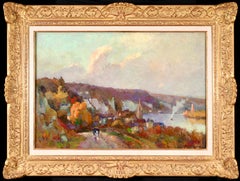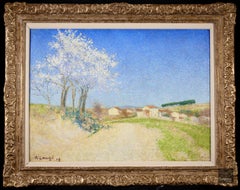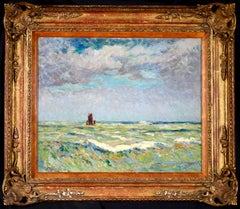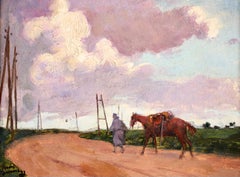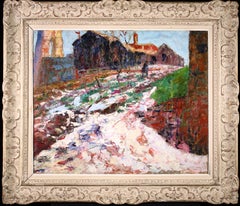Leighton Fine Art Ltd
to
1
20
38
76
50
9
Overall Width
to
Overall Height
to
31
162
30
38
37
13
8
10
3
2
8
2
96
74
7
2
1
152
39
1
102
39
13
12
12
12
12
11
7
7
6
5
5
5
4
4
4
4
3
3
187
176
119
119
35
9
7
7
6
6
191
193
Duclair - La Seine - Post Impressionist Oil, River Landscape by Robert Pinchon
By Robert Antoine Pinchon
Located in Marlow, Buckinghamshire
Fauvist signed oil on canvas riverscape circa 1920 by French post impressionist painter Robert Antoine Pinchon. The work depicts a view of the R...
Category
1920s Post-Impressionist Landscape Paintings
Materials
Canvas, Oil
Belveze du Razes - Neo-Impressionist Pointillist Oil, Landscape by Achille Lauge
By Achille Laugé
Located in Marlow, Buckinghamshire
Stunning pointillist landscape oil on panel by French neo-impressionist painter Achille Lauge. The work depicts a path leading to the small village of Belveze du Razes in the South of France on a bright spring day. To the left are white blossom trees in bloom and the houses of the village can be seen in the distance.
Signature:
Signed and dated 1909 lower left
Dimensions:
Framed: 28"x36"
Unframed: 21"x29"
Provenance:
We kindly thank Mme. Nicole Tamburini for allowing us to state that the work is included in the Catalogue Raisonne of the artist which she is currently preparing.
A certificate of authenticity from Mme. Tamburini is available upon request.
Achille Laugé...
Category
Early 1900s Pointillist Landscape Paintings
Materials
Oil, Canvas
Grosse Mer - Etretat - Impressionist Seascape Landscape Oil by Maxime Maufra
By Maxime Maufra
Located in Marlow, Buckinghamshire
Impressionist oil on canvas seascape painting circa 1895 by French artist Maxime Maufra. This stunning work depicts a sailing boat on a vast ocean. The choppy water is painted in greens and blues. The white clouds rolling across the blue sky are beautifully shaded in purple tones.
Signature:
Signed lower left and titled on original label verso
Dimensions:
Framed: 22"x25"
Unframed: 15"x18"
Provenance:
This work is included in the catalogue raisonne of Maxime Maufra under reference 284
Durand-Ruel, Paris (acquired directly from the artist on 5 April 1895)
Durand-Ruel Galleries, New York (acquired from the above in 1895)
Marlborough Fine Arts, Ltd., London (acquired after 1949)
Dr. Renate Davis, London (acquired from the above)
Lyon & Turnbull London, 28 November 2013, lot 111 (consigned by the above)
Private Collection, New York (acquired from the above sale)
Sotheby's New York, 15 November 2017, lot 101 (consigned by the above)
Maufra spent several years in England, notably in Liverpool, with his father, who wanted him to become a tradesman. He decided to take up painting instead and returned to France in 1883, attracting the attention of Octave Mirbeau in his very first exhibition, and subsequently being noticed by Frantz Jourdain in 1894 and Fontenais in 1901. In 1886, he successfully exhibited two seascapes at the Salon, following which he visited Brittany in 1890, making the acquaintance of Gauguin and Sérusier in Pont-Aven; he collaborated with them on the decoration of the Pouldu Inn in 1894. He maintained his acquaintance with the Nabis group artists Henry Moret and Gustave Loiseau. He travelled in l'Isère, Belgium, and Algeria (1913), as well as Paris, the Ile de France, Brittany and Normandy. From 1895, the Galerie Durand-Ruel assured the success of his work.
Maufra settled in Montmartre for about ten years during which he painted the old quarters of Paris, often around the church of St Séverin. He then turned to Brittany and Normandy for inspiration in keeping with a resolve to paint only from nature, his seascapes in particular finding favour. The influence of the Nabis on his work remains limited except in the 'synthetic' organisation of the composition. He was an admirer of Sisley and Pissarro, whose influence can be seen in his paintings. Maufra, like Valtat, went to some extent beyond Impressionism to become a forerunner of Fauvism in his use of colour.
An important retrospective exhibition of Maufra's work, prefaced by René Domergue, was organised in Paris around 1950. In 2001, his work was represented in the exhibition Painters and the Sarthe Region ( Les Peintres et la Sarthe) held at the Musée de la Reine Bérengère (for the 19th century) and the Abbaye de l'Épau (for the 20th century) at Le Mans. In 2003, his work appeared in the group exhibition Brittany, Land of Painters ( Bretagne, Terre des Peintres) at the Musée des Beaux-Arts in Vannes.
Museum and Gallery Holdings:
Bergues: Seascapes
Boston: Dusk in Douarnenez; Departure of Fishing Boats
Buffalo: Transport Quittant Le Havre
Chicago: Douarnenez the Town of Light
Cholet: Flood
Cincinnati (AM): The Coast, Bay of Douarnenez (Vue de Douarnenez) (painting)
Helsinki: St-Guénolé
Le Havre: Moonrise in Brittany
Manchester: Springtime in Lavardin
Montpellier: Hills of Morgat
Mulhouse: Low Tide
Nantes (MBA): La Prairie d'Amont (1888, oil on canvas); Pointe du Raz; Heavy Swell; The Loir Dam in Poncé (oil on canvas)
Paris (Mus. d'Orsay): Brittany Landscape...
Category
1890s Impressionist Landscape Paintings
Materials
Canvas, Oil
Demonstrators - Impressionist Oil, Figures in City Landscape by Andre Devambez
By André Devambez
Located in Marlow, Buckinghamshire
Wonderful figures in night landscape oil on canvas circa 1904 by French impressionist painter and illustrator Andre Devambez. The piece depicts demonstr...
Category
Early 1900s Impressionist Figurative Paintings
Materials
Canvas, Oil
The Great War - Impressionist Oil, Figure & Horse in Landscape by Andre Devambez
By André Devambez
Located in Marlow, Buckinghamshire
Wonderful oil on panel circa 1920 by French impressionist painter Andre Devambez. The work depicts a soldier leading his horse along a dirt track during...
Category
1910s Impressionist Animal Paintings
Materials
Oil, Panel
Woman in Snow - Post Impressionist Oil, Figure in Landscape by Victor Charreton
By Victor Charreton
Located in Marlow, Buckinghamshire
Large signed landscape oil on canvas circa 1920 by sought after French post impressionist painter Victor Charreton, who was known as the painter of colours. The work depicts a woman walking through a snowy village in winter. The piece is beautifully coloured.
Signature:
Signed lower right
Dimensions:
Framed: 33"x38"
Unframed: 24"x29"
Provenance:
Private collection - Portugal
Ader - Paris
Charreton was a landscape artist in the Lyons tradition with a love of sensual impasto. In his works he seeks to capture fleeting, momentary effects, like those achieved by the Impressionists: effects at different times of day and in different seasons, such as dusk and snow. As a young man he painted the environs of Bourgoin. Skilled in capturing minute changes in the weather, he was also adept at capturing the spirit of new places. Beside his native Dauphiné and his adopted Auvergne, he was also charmed by the landscapes of the Île-de-France and Paris - Montmartre, the Jardin du Luxembourg and the Parc Montsouris...
Category
1920s Post-Impressionist Landscape Paintings
Materials
Oil, Canvas
Winter - Fontainbleau Forest - Impressionist Oil, Landscape by Victor Vignon
By Victor Alfred Paul Vignon
Located in Marlow, Buckinghamshire
Signed figures in a landscape oil on canvas circa 1870 by French impressionist painter Victor Alfred Paul Vignon. The work depicts a woman carrying a basket with a young child beside her walking along a snowy path in a Fontainebleau Forest. This early work by Vignon was painted whilst he was under the tutelage of Camille Corot in the period between 1869 and 1870 . The work shows a mother and child in the forest at Fontainebleau in winter. Many painters in Vignon's circle such as Monet, Renoir, Sisley and Bazille visited this area to paint in the late 1860's and the early 1870's.
Signature:
Signed lower left
Dimensions:
Framed: 23"x25.5"
Unframed: 13.5"x16"
Provenance:
Galerie Commeter - Hamburg c. 1920
French exhibition customs stamps verso
His mother has been incorrectly identified as the writer Claude Vignon...
Category
1870s Impressionist Landscape Paintings
Materials
Canvas, Oil
Deux vieillards aux chatons - Impressionist Figurative Oil by J F Raffaelli
By Jean-Francois Raffaelli
Located in Marlow, Buckinghamshire
Signed figures in interior oil on panel by French impressionist painter Jean-Francois Raffaelli. The piece depicts two old men seated in an interior. One is reading his paper as the other naps and there are several kittens on the floor. Painted in the artist's distinctive style.
Signature:
Signed lower left
Dimensions:
Framed: 9.5"x8"
Unframed: 5.5"x4"
Provenance:
Brame & Lorenceau have confirmed the authenticity of this work and it will be included in the digital catalogue raisonne of the painter which is under preparation
A certificate of authenticity fromBrame & Lorenceau accompanies this painting
Private collection - United States
Original artists label verso
Jean-François Raffaëlli's father was a failed Italian businessman and Raffaëlli himself was, among other things, a church chorister, actor and theatre singer. He then studied under Gérôme at the École des Beaux-Arts in Paris. He travelled to Italy, Spain and Algeria and on his return to France settled in Asnières.
In 1876, on a trip to Brittany, he first saw the potential of realist subject matter, if treated seriously. He became involved in meetings of artists at the Café Guerbois, where the Impressionist painters used to gather. As a result, Degas, contrary to the advice of the group, introduced Raffaëlli to the Impressionist exhibitions - according to one uncertain source as early as the very first exhibition, at the home of Nadar, and certainly to those of 1880 and 1881.
In 1904, Raffaëlli founded the Society for Original Colour Engraving. He first exhibited at the Salon de Paris in 1870 and continued to exhibit there until he joined the Salon des Artistes Français in 1881, where he earned a commendation in 1885, was made Chevalier of the Légion d'Honneur in 1889 and in the same year was awarded a gold medal at the Exposition Universelle. In 1906 he was made Officier of the Légion d'Honneur. He was also a member of the Société Nationale des Beaux-Arts. In 1884, a private exhibition of his work cemented his reputation.
He contributed to several newspapers such as The Black Cat (Le Chat Noir) in 1885 and The French Mail (Le Courrier Français) in 1886 and 1887. He published a collection entitled Parisian Characters, which captured his favourite themes of the street, the neighbourhood and local people going about their lives. In 1880 he participated, with Forain, on the illustration of Joris Karl Huysmans' Parisian Sketches (Croquis Parisiens). He also illustrated Huysman's Works. As well as working as an illustrator, he also made etchings and coloured dry-points.
His early attempts at painting were genre scenes, but once he was settled in Asnières he started to paint picturesque views of Parisian suburbs. From 1879 onwards, his subject matter drew on the lives of local people. These popular themes, which he treated with humanity and a social conscience, brought him to the attention of the social realist writers of the time such as Émile Zola. In addition to his realist style, Raffaëlli's dark palette, which ran contrary to the Impressionist aesthethic, helped to explain the opposition of those painters to his participation in their exhibitions. More concerned with drawing than colour, he used black and white for most of his paintings. Towards the end of his life, he lightened his palette, but without adopting any other principles of the Impressionist technique.
After painting several portraits, including Edmond de Goncourt and Georges Clémenceau, he returned to genre painting, particularly scenes of bourgeois life. Later in his career, he painted mainly Breton-inspired sailors and views of Venice. His views of the Paris slums and the fortifications, sites which have almost completely disappeared, went some way towards establishing a genre in themselves and perpetuated the memory of the area: The Slums, Rag-and-Bone Man, Vagabond, Sandpit, In St-Denis, Area of Fortifications. His realistic and witty portrayal of typical Parisian townscapes accounts for his enduring appeal.
Born in Paris, he was of Tuscan descent through his paternal grandparents. He showed an interest in music and theatre before becoming a painter in 1870. One of his landscape paintings was accepted for exhibition at the Salon in that same year. In October 1871 he began three months of study under Jean-Léon Gérôme at the École des Beaux-Arts in Paris; he had no other formal training.
Raffaëlli produced primarily costume pictures until 1876, when he began to depict the people of his time—particularly peasants, workers, and ragpickers seen in the suburbs of Paris—in a realistic style. His new work was championed by influential critics such as J.-K. Huysmans, as well as by Edgar Degas.
The ragpicker became for Raffaëlli a symbol of the alienation of the individual in modern society. Art historian Barbara S. Fields has written of Raffaëlli's interest in the positivist philosophy of Hippolyte-Adolphe Taine, which led him to articulate a theory of realism that he christened caractérisme. He hoped to set himself apart from those unthinking, so-called realist artists whose art provided the viewer with only a literal depiction of nature. His careful observation of man in his milieu paralleled the anti-aesthetic, anti-romantic approach of the literary Naturalists, such as Zola and Huysmans.
Degas invited Raffaëlli to participate in the Impressionist exhibitions of 1880 and 1881, an action that bitterly divided the group; not only was Raffaëlli not an Impressionist, but he threatened to dominate the 1880 exhibition with his outsized display of 37 works. Monet, resentful of Degas's insistence on expanding the Impressionist exhibitions by including several realists, chose not to exhibit, complaining, "The little chapel has become a commonplace school which opens its doors to the first dauber to come along."An example of Raffaëlli's work from this period is Les buveurs d'absinthe (1881, in the California Palace of Legion of Honor Art Museum in San Francisco). Originally titled Les déclassés, the painting was widely praised at the 1881 exhibit.
After winning the Légion d'honneur in 1889, Raffaëlli shifted his attention from the suburbs of Paris to city itself, and the street scenes that resulted were well received by the public and the critics. He made a number of sculptures, but these are known today only through photographs.[2] His work was also part of the painting event in the art competition at the 1912 Summer Olympics. In the later years of his life, he concentrated on color printmaking. Raffaëlli died in Paris on February 11, 1924
Museum and Gallery Holdings:
Béziers: Peasants Going to Town
Bordeaux: Bohemians at a Café
Boston: Notre-Dame; Return from the Market
Brussels: Chevet of Notre-Dame; pastel
Bucharest (Muz. National de Arta al României): Market at Antibes; Pied-à-terre
Copenhagen: Fishermen on the Beach
Douai: Return from the Market; Blacksmiths
Liège: Absinthe Drinker...
Category
1890s Impressionist Figurative Paintings
Materials
Oil, Panel
View of New York - Post Impressionist Oil, Cityscape by Jacques Martin-Ferrieres
By Jacques Martin-Ferrières
Located in Marlow, Buckinghamshire
A stunning oil on canvas urban landscape by sought after French post-impressionist painter Jacques Martin-Ferrieres. The piece depicts a very rare view of the Manhattan skyline - pai...
Category
1940s Post-Impressionist Landscape Paintings
Materials
Canvas, Oil
Stormy Weather - Honfleur - Post Impressionist Oil, Seascape by H de Saint-Delis
Located in Marlow, Buckinghamshire
A wonderful oil on canvas circa 1908 by French post impressionist painter Henri Liénard de Saint-Délis depicting a boat docked at the harbour in the harb...
Category
Early 1900s Post-Impressionist Landscape Paintings
Materials
Oil, Canvas
Allotments - La Sargne - Post-Impressionist Oil, Landscape by Victor Charreton
By Victor Charreton
Located in Marlow, Buckinghamshire
A charming oil on board circa 1910 by sought after Post-Impressionist painter Victor Charreton. Charreton was said to be the painter of colours and this piece, which depicts an allot...
Category
1910s Post-Impressionist Landscape Paintings
Materials
Oil, Board
Sur la Plage - Impressionist Oil, Figures in Coastal Landscape by Alfred Stevens
By Alfred Émile Léopold Stevens
Located in Marlow, Buckinghamshire
Signed and dated figures in seascape oil on panel by Belgian impressionist painter Alfred Emile Leopold Stevens. The work depicts an elega...
Category
1890s Impressionist Figurative Paintings
Materials
Oil, Panel
Evening in Paris - 20th Century Oil, Figures in Cityscape at Night - Louis Hayet
By Louis Hayet
Located in Marlow, Buckinghamshire
A wonderful oil on canvas by Louis Hayet depicting figures in a cityscape at evening time. Signed and dated 1932 lower left.
Louis Hayet had a difficult and itinerant childhood, due to the instability of his father, an amateur artist. He began to draw and produce watercolours from the age of 12. By the age of 20 he produced works with great skill, as demonstrated by his pen drawing Boulevard, Evening, Paris. He made a living in Paris doing various jobs more or less to do with painting. He associated with Camille and Lucien Pissaro...
Category
1930s Post-Impressionist Figurative Paintings
Materials
Canvas, Oil, Board
